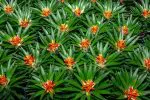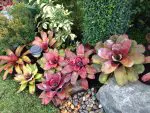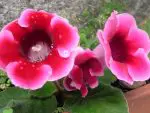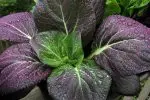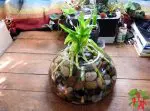This post contains affiliate links. If you buy something from one of our links we may earn a commission. Thanks
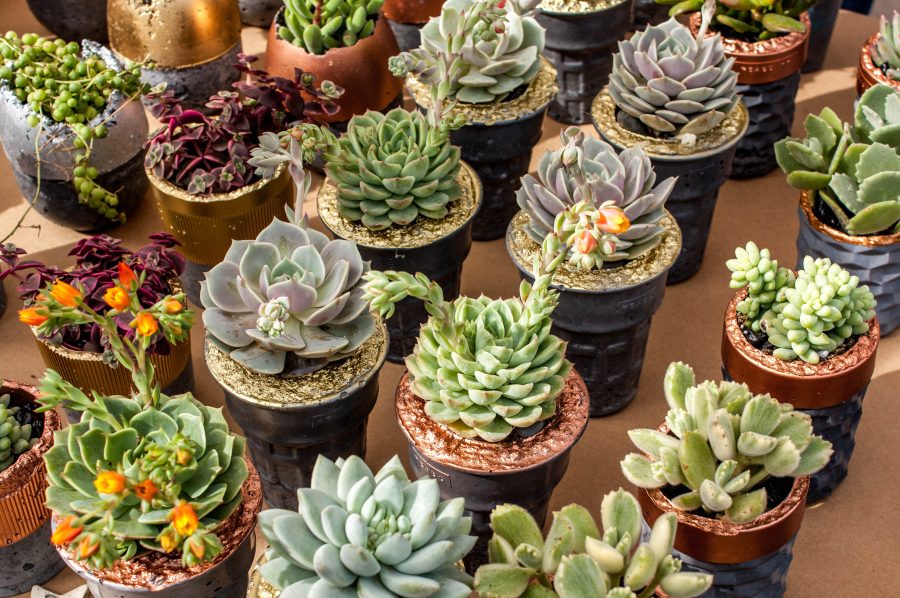
Discover the fascinating world of air plants vs succulents! Dive into their unique features, care requirements, and aesthetics to find your perfect low-maintenance plant.
Air plants and succulents differ primarily in their care requirements and root structures. Air plants absorb nutrients and water through trichomes on their leaves and do not need soil, while succulents have roots and require soil for nutrient absorption. Succulents generally need less frequent watering than air plants and are often more tolerant of direct sunlight.
Welcome to the captivating realm of air plants vs succulents!
As the stars of the low-maintenance plant world, these two botanical beauties have taken the hearts of plant enthusiasts by storm.
But with their unique care requirements, stunning aesthetics, and diverse benefits, how can one decide which of these incredible plants is the perfect addition to their space?
We’re here to dive into the key differences between air plants and succulents, helping you make an informed choice and find the ideal plant companion for your lifestyle.
Introduction: Air Plants Vs Succulents
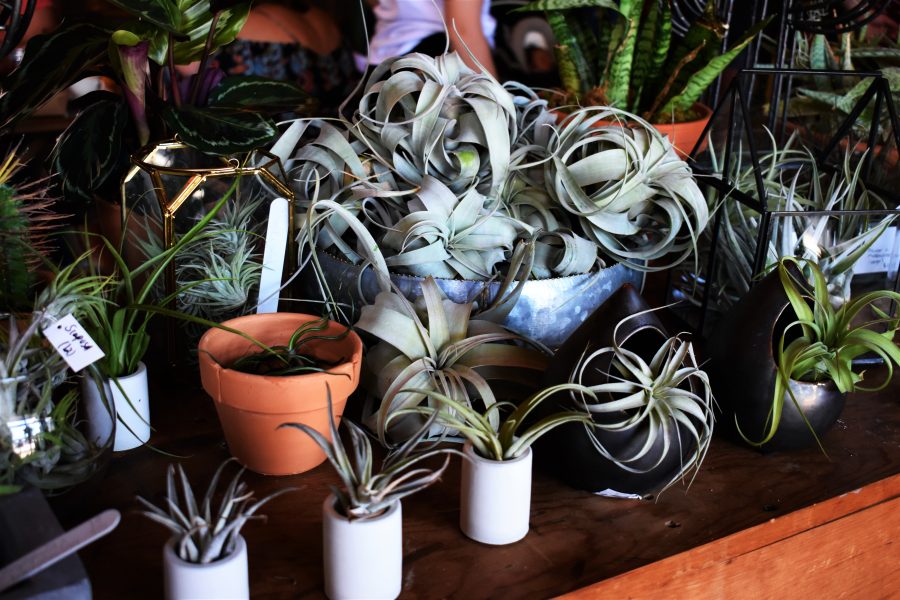
Are you ready for an exciting journey into the world of air plants and succulents?
These two low-maintenance gems have been sprouting up in homes and offices everywhere, bringing joy and greenery to countless spaces.
But, with so many options out there, how can you determine which plant type is the right fit for you?
No worries, we’re here to help! We’ll explore the unique qualities, care needs, and visual appeal of both air plants and succulents, empowering you to make the perfect choice for your plant family.
Let’s dive in and embrace the green goodness together!
Meet Air Plants and Succulents
First things first, let’s get to know our stars: air plants and succulents.
Both these charming plant types are known for their low-maintenance nature and unique adaptations, making them great choices for busy plant parents or those with less-than-green thumbs.
They come in a variety of shapes, sizes, and colors, offering endless possibilities for sprucing up your space.
Why Compare Air Plants and Succulents?
So, why are we comparing air plants and succulents, you ask?
Well, even though they both fall under the low-maintenance category, they have distinct care requirements and characteristics that might make one a better fit for your lifestyle and preferences.
By comparing these two plant types, we’ll help you make an informed decision when it comes to expanding your indoor jungle.
Sneak Peek: Comparison Highlights
As we dive into this friendly discussion, we’ll be covering some key comparison points, such as care requirements, aesthetic appeal, propagation and growth, benefits, and common issues.
We’ll also touch on how to choose the right plant based on your lifestyle, space, and environmental factors.
Ready to delve deeper into the enchanting world of air plants and succulents? Let’s get started!
What Are Air Plants?
Now that we’ve set the stage, let’s dive into the magical world of air plants!
These fascinating little wonders might look like they’re straight out of a fairy tale, and their unique features are bound to leave you in awe.
You may have seen them perched on driftwood or nestled in a terrarium, but have you ever wondered what makes air plants so special?
Well, buckle up, because we’re about to embark on an exciting journey to uncover the captivating charm of air plants and explore their incredible diversity in appearance and species. Trust us, you’re in for a treat!
Meet the Tillandsias
Let’s start by introducing you to the air plants and their official name Tillandsia.
With over 650 species, Tillandsias belong to the Bromeliad family, and they’ve truly earned their popularity among plant enthusiasts.
They are epiphytes, which means they grow on other plants or structures without causing any harm to their hosts. How cool is that?
Home Sweet Habitat & Unique Features
Air plants are native to the forests, mountains, and deserts of Central and South America, as well as the southern United States.
Their unique features include the ability to absorb nutrients and water through their leaves instead of roots, which is why they don’t need soil to survive.
This incredible adaptation allows air plants to thrive in diverse environments, making them a fascinating addition to any plant collection.
A World of Species and Appearances
One of the best things about air plants is their incredible variety.
With hundreds of species to choose from, you’ll find air plants in all sorts of shapes, sizes, and colors.
Some air plants boast stunning, bright blooms, while others mesmerize with their intricate leaf patterns.
The sheer diversity of Tillandsias means there’s an air plant out there that’s perfect for everyone – and you’ll have a blast exploring their captivating world!
What Are Succulents?
Now that we’ve explored the enchanting world of air plants, it’s time to turn our attention to another beloved plant group – succulents!
These adorable, fleshy plants have been taking over social media feeds and windowsills everywhere, and it’s easy to see why.
With their incredible variety, unique features, and seemingly endless shapes and colors, succulents have something for everyone.
So, let’s get up close and personal with these captivating plants and find out what makes them such a popular choice for green thumbs and novices alike.
Get ready to fall in love with the amazing world of succulents!
Succulents Uncovered: Definition & Characteristics
Let’s start by getting to know what succulents really are.
Succulents are a diverse group of plants known for their thick, fleshy leaves or stems, which they use to store water.
This unique adaptation allows them to survive in arid environments and go for longer periods without water. Talk about low maintenance!
Popular Succulent Types: Echeveria, Aloe, Jade & More
The world of succulents is incredibly vast, with thousands of species and varieties to choose from.
Some fan favorites include the rosette-forming Echeveria, the ever-soothing Aloe, and the classic Jade plant.
With so many delightful options, it’s easy to see why succulents have become a staple in plant collections everywhere.
Home, Sweet Home: Native Habitats & Adaptations
Succulents are native to a wide range of habitats, from deserts and semi-deserts to mountain regions and even rainforests.
Their unique adaptations, like water-storing leaves and shallow root systems, allow them to thrive in challenging environments where water is scarce.
These amazing survival skills make succulents not only fascinating to learn about but also a fantastic choice for plant enthusiasts looking for low-maintenance greenery.
Care Requirements
Alright, now that we’ve gotten to know air plants and succulents a bit better, it’s time to talk about their care requirements.
After all, no matter how much we love our green friends, they won’t thrive without a bit of TLC!
So, whether you’re a busy plant grower or someone new to the world of indoor gardening, understanding the basic needs of these low-maintenance gems is essential.
In this section, we’ll walk you through the ins and outs of caring for air plants and succulents, so you can keep them happy, healthy, and looking their best.
Let’s dive in and unlock the secrets to keeping these captivating plants in tip-top shape!
Watering Wonders
Air Plants: Misting and Soaking
When it comes to air plants, they have their own unique watering needs.
You can keep them hydrated by misting them a few times a week, depending on your environment’s humidity.
Alternatively, you can give them a good soak every 1-2 weeks by submerging them in water for about 20-30 minutes.
Just be sure to shake off excess water and let them dry upside down to prevent rot.
Succulents: Infrequent Deep Watering
Succulents, on the other hand, prefer a deep drink every now and then.
Allow the soil to dry out completely between waterings, and then drench the soil until water flows out of the drainage holes.
This watering method mimics their natural habitat and helps prevent overwatering, which can lead to root rot.
Let There Be Light
Air Plants: Indirect Sunlight and Artificial Light
Air plants love bright, indirect sunlight or artificial light.
Placing them near a window with filtered light or under a fluorescent light source will keep them happy and healthy.
Just avoid exposing them to direct sunlight for extended periods, as this can cause their leaves to scorch.
Succulents: Direct Sunlight and Proper Light Exposure
Most succulents enjoy bright, direct sunlight for at least 4-6 hours a day.
Make sure to gradually acclimate them to increased light levels, as sudden changes can cause sunburn.
If you notice your succulent stretching or leaning towards the light, it might need more sunlight to maintain its compact shape.
Temperature and Humidity Tango
Air Plants: Preferences and Tolerances
Air plants prefer temperatures between 50-90°F (10-32°C) and can tolerate a wide range of humidity levels.
However, if you live in a dry environment, you may need to adjust their watering routine to keep them adequately hydrated.
Succulents: Temperature and Humidity Requirements
Succulents are generally happiest in temperatures ranging from 60-80°F (15-27°C), with some able to tolerate colder or warmer conditions.
They prefer low humidity, so make sure your space is well-ventilated to prevent excess moisture buildup, which can lead to fungal issues or rot.
Soil and Potting Solutions
Air Plants: No Soil Needed, Mounting Options
One of the coolest things about air plants is that they don’t need soil!
You can mount them on various surfaces like driftwood, cork, or even seashells.
Alternatively, you can place them in terrariums or glass globes, but ensure proper air circulation to keep them healthy.
Succulents: Well-Draining Soil and Pot Selection
Succulents need well-draining soil to prevent root rot. A good-quality cactus or succulent mix is ideal.
You can create your own by combining potting soil with perlite or coarse sand.
A 50/50 mix of coco coir and perlite also makes an excellent potting medium for succulents.
When choosing a pot, opt for one with drainage holes and avoid materials that retain moisture, like glass or plastic.
Terracotta pots are a popular choice, as they help wick away excess moisture from the soil.
Aesthetic Appeal
As we delve deeper into the alluring realms of air plants and succulents, it’s hard to ignore their undeniable aesthetic appeal.
These charming plants have a knack for capturing our hearts and transforming our living spaces with their unique shapes, colors, and textures.
In this section, we’ll explore the visual delights that these two plant types offer and how they can add a touch of magic to your home or garden.
So, prepare to be captivated and inspired as we take a closer look at the stunning world of air plant and succulent aesthetics.
Let your inner artist run wild and discover the endless design possibilities that await!
Air Plants: A Whirlwind of Unique Shapes and Colors
Air plants are true showstoppers, boasting a diverse range of shapes, sizes, and colors.
With their captivating forms, from the delicate curves of Tillandsia ionantha to the dramatic twists of Tillandsia bulbosa, these plants are sure to leave a lasting impression.
And don’t forget about their vibrant colors – some air plants even produce stunning blooms that add an extra pop of color to your space!
Succulents: A Kaleidoscope of Diverse Forms and Textures
Succulents are renowned for their incredible variety in form and texture.
From the rosette-shaped elegance of Echeverias to the plump leaves of Jade plants and the spiky allure of Aloes, there’s a succulent to suit every taste.
Their diverse appearance allows for endless combinations and striking arrangements, making them an irresistible choice for plant lovers.
Display Options Galore: Showcasing Both Plant Types
Both air plants and succulents offer a world of creative display possibilities.
Air plants thrive without soil, allowing you to mount them on various surfaces, suspend them in the air, or nestle them in glass terrariums.
Succulents, on the other hand, are perfect for creating eye-catching potted arrangements, adding a touch of green to windowsills, or even designing an outdoor succulent garden.
With so many options, you can let your imagination soar and design a green space that reflects your unique style and personality.
Propagation and Growth
As we continue our journey into the world of air plants and succulents, let’s talk about one of the most rewarding aspects of plant parenthood – propagation and growth!
There’s just something magical about helping your green friends multiply and thrive.
Whether you’re looking to expand your collection or share the plant love with friends and family, understanding how to propagate and care for your air plants and succulents is essential.
In this section, we’ll explore the different methods and tips for successful propagation and growth, so you can watch your plant family flourish.
Let’s dive in and learn how to nurture new life from our favorite low-maintenance plants!
Air Plants: The Magic of Pups and Division
Air plants reproduce by producing small offshoots, called pups, which grow at the base of the mother plant.
When pups are about 1/3 the size of the parent plant, you can gently separate them by twisting or using a clean pair of scissors.
Voilà! You’ve got yourself a brand-new air plant ready to grow and thrive.
Succulents: Leaf Cuttings, Offsets, and Seeds, Oh My!
Succulents offer a variety of propagation methods, including leaf cuttings or stem cuttings, offsets (also known as pups), and seeds.
For leaf cuttings and stem cuttings, gently twist off a healthy leaf or snip off a stem with a few leaves and a bit of bare stem, let it callous over for a few days, and then place it on well-draining soil.
Offsets can be carefully removed from the mother plant and replanted.
If you’re feeling adventurous, you can also try growing succulents from seeds, although this method requires more patience and care.
Timeframes and Success Rates: Patience is Key
Propagation timeframes and success rates can vary widely depending on the plant species and method used.
For air plants, pups can take several months to grow large enough for separation.
In the case of succulents, leaf or stem cuttings can take anywhere from 2-6 weeks to sprout roots and offsets may need a few weeks to establish themselves.
Growing succulents from seeds can take months, or even years, to reach a mature size. It’s important to be patient, as not every attempt will be successful, but the joy of seeing new life emerge is well worth the wait!
Benefits of Each Plant Type
As we’ve been diving deeper into the captivating world of air plants and succulents, you may be wondering, “What’s in it for me?”
Well, aside from their undeniable charm and aesthetic appeal, these low-maintenance plant buddies offer a variety of benefits that can enhance your life and living space.
In this section, we’ll explore some of the wonderful perks that come with being a proud air plant or succulent owner.
From improving air quality to boosting your mood and creativity, these delightful green companions are more than just pretty faces.
Let’s uncover the hidden benefits of each plant type and discover how they can make your world a little greener and happier!
The Wonderful World of Air Plants
• Breathe Easy: Air Purification
Air plants are natural air purifiers, helping to remove pollutants and improve indoor air quality.
By absorbing harmful substances through their leaves, these little wonders contribute to a healthier and fresher living space.
• Display in Style: Versatility in Display Options
With their no-soil-required nature, air plants offer endless possibilities for creative displays.
From mounting them on driftwood or cork to placing them in terrariums, you can let your imagination run wild and create eye-catching arrangements that suit your personal style.
• Keep It Simple: Low-Maintenance Care
Air plants are perfect for busy plant parents or those who are just starting their plant journey.
Their ability to thrive without soil and adapt to various light conditions, combined with their minimal watering needs, make them a fuss-free choice for any home.
The Allure of Succulents
• The Thirst Is Real: Drought Tolerance
Succulents are champions of drought tolerance, thanks to their water-storing leaves and stems.
This amazing adaptation makes them ideal for those who might forget to water their plants from time to time or for water-conscious gardeners.
• Stand Out from the Crowd: Unique Visual Appeal
With their diverse shapes, colors, and textures, succulents offer a unique visual appeal that’s hard to resist.
They make stunning additions to any room, windowsill, or outdoor space, and their distinct charm is sure to capture attention and admiration.
• Share the Love: Easy Propagation
One of the most rewarding aspects of succulent ownership is how easily they propagate.
With multiple methods like leaf cuttings, offsets, and seeds, you can expand your collection or share the succulent love with friends and family – making them the gift that keeps on giving!
Common Issues and Troubleshooting
While air plants and succulents are generally low-maintenance and easy to care for, they’re not immune to the occasional hiccup or challenge.
Just like any other living thing, they can experience a few bumps in the road. But don’t worry!
We’re here to help you troubleshoot and tackle those common issues, so your plant babies can continue to thrive.
In this section, we’ll discuss some of the most common problems that air plant and succulent owners may encounter, along with tips and tricks for getting your green friends back on track.
With a little knowledge and TLC, you’ll be well-equipped to handle any curveballs your plants may throw your way.
Let’s roll up our sleeves and dive into the world of troubleshooting!
Air Plant Troubles: Don’t Panic, We’ve Got Solutions!
• Browning Tips and Leaves: Finding the Balance
Browning tips or leaves on air plants can be a sign of underwatering or low humidity.
To remedy this, try increasing the frequency of misting or soaking, and consider placing a small dish of water nearby to raise humidity levels.
Just be sure not to overdo it, as excessive moisture can lead to other problems.
• Rotting and Overwatering: Less Is More
If your air plant appears to be rotting, it’s likely a result of overwatering or insufficient drying after watering.
To prevent this, always shake off excess water and let your plant dry upside down in a well-ventilated area.
Adjust your watering schedule and ensure proper air circulation to keep your air plant healthy and happy.
Succulent Solutions: Tackle Common Issues with Confidence
• Overwatering and Root Rot: Timing Is Everything
Overwatering is a common issue for succulents, often leading to root rot.
To avoid this, make sure the soil dries out completely between waterings and use a well-draining soil mix.
Remember, it’s better to err on the side of underwatering when it comes to succulents.
Keep an eye on their leaves for signs of thirst, like wrinkling or wilting, to help you gauge when it’s time to water.
• Pests and Diseases: Prevention and Treatment
Succulents can be susceptible to pests like mealybugs, spider mites, or scale insects, as well as fungal diseases.
To prevent these issues, maintain a clean growing environment, provide proper ventilation, and avoid overwatering.
If your succulent does fall victim to pests or diseases, try removing badly affected leaves or stems and treat the plant with insecticidal soap or neem oil, following the manufacturer’s instructions.
Choosing the Right Plant for You
We’ve taken quite the journey through the enchanting worlds of air plants and succulents, and by now, you might be wondering which of these fantastic plant friends is the best fit for you.
Don’t worry, we’re here to help! In this final section, we’ll provide you with some guidance on how to choose the right plant based on your lifestyle, living space, and personal preferences.
After all, the key to a successful plant growing experience is finding a green companion that not only suits your aesthetic but also thrives under your care.
So, let’s dive in and discover which of these delightful low-maintenance plants will make the perfect addition to your home or garden!
Lifestyle Considerations: Matching Your Plant to Your Pace
Taking into account your daily routine and habits is essential when choosing the right plant for you.
If you travel often or have a busy lifestyle, air plants or drought-tolerant succulents can be great options due to their low-maintenance care requirements.
Space and Display Preferences: Find Your Plant Style
Consider the space you have available and your preferred way of displaying plants.
If you love creative arrangements and versatile display options, air plants can be a perfect fit.
On the other hand, if you enjoy the look of potted plants, succulents offer a wide variety of shapes and colors to suit any design aesthetic.
Climate and Environmental Factors: Happy Plants, Happy Life
The climate and environment in your home or garden play a crucial role in determining which plant is best for you.
Air plants prefer higher humidity levels and indirect light, while succulents thrive in bright light and can tolerate drier conditions.
Choose a plant that will feel at home in your space to ensure its health and happiness.
Can’t Decide? Why Not Grow Both? Embrace Plant Diversity
If you’re still torn between air plants and succulents, why not give both a try?
Growing a mix of these low-maintenance plants allows you to enjoy the unique benefits and aesthetics of each, while also adding variety and interest to your home or garden.
After all, the more, the merrier when it comes to plant friends!
Air Plants Vs Succulents FAQs
Air Plants Vs Succulents Final Thoughts
Air plants and succulents are both fascinating choices for indoor gardening, but they come with their own unique care requirements and benefits.
Whether you’re trying to decide between the two or considering adding both to your collection, you likely have some questions.
To help you navigate this green landscape, we’ve put together answers to some commonly asked questions.
Q: Are air plants easier than succulents?
A: This depends on your lifestyle and environment. Air plants require frequent misting and occasional soaking, while succulents generally need less frequent watering. However, air plants don’t require soil, which can simplify things.
Q: Are air plants the same as succulents?
A: No, air plants and succulents are not the same. Air plants are in the Tillandsia genus and absorb water through their leaves, while succulents have roots that absorb water and they often store water in their leaves or stems.
Q: Can you mix succulents and air plants?
A: You can display them together, but they have different care requirements. Air plants need higher humidity and more frequent watering compared to most succulents, which prefer a drier environment.
Q: Are air plants good for anything?
A: Beyond their ornamental value, air plants are known for being relatively easy to care for and can be placed in a variety of locations around the home. However, they don’t have any significant air-purifying capabilities as is often assumed.
Well, there you have it – our in-depth exploration of the captivating worlds of air plants and succulents has come to an end.
We’ve covered everything from their origins and care requirements to their benefits and potential challenges.
Now that you’re armed with all this knowledge, you’re well on your way to making an informed decision about which plant friend is the perfect fit for your lifestyle and home.
Whether you choose to embrace the ethereal beauty of air plants, the striking charm of succulents, or decide to welcome both into your green family, remember that the key to a successful plant growing experience is patience, love, and a little bit of know-how.
Happy planting, and may your home be evergreen and thriving!
Recap Time: Key Differences Air Plants Vs Succulents
As we’ve journeyed through the fascinating realms of air plants and succulents, we’ve discovered that each plant type offers unique characteristics and care requirements.
From air plants’ soil-free lifestyle and love for humidity to succulents’ drought tolerance and sun-seeking nature, these charming green companions cater to a wide range of preferences and environments.
Adventure Awaits: Explore Both Plant Types and Find Your Perfect Match
We encourage you to dive into the world of air plants and succulents, and discover which one best fits your needs.
Or even better, explore the possibility of growing both!
By immersing yourself in the diverse and enchanting worlds of these low-maintenance plants, you’re bound to find the perfect green companion that will bring joy, beauty, and a touch of nature into your life. Happy planting!
Learn more about how to care for Bromeliads.













